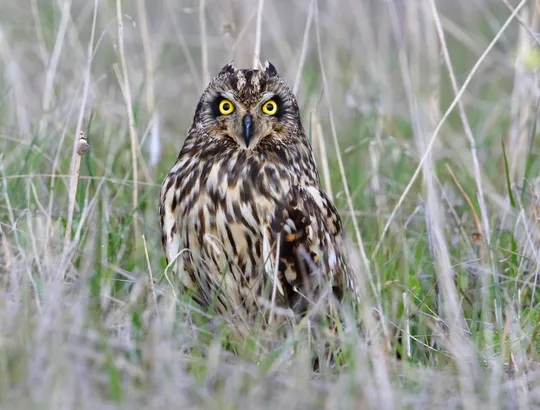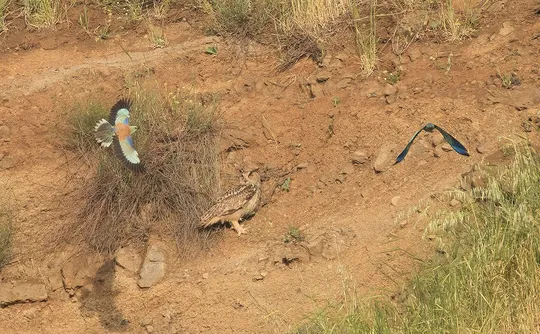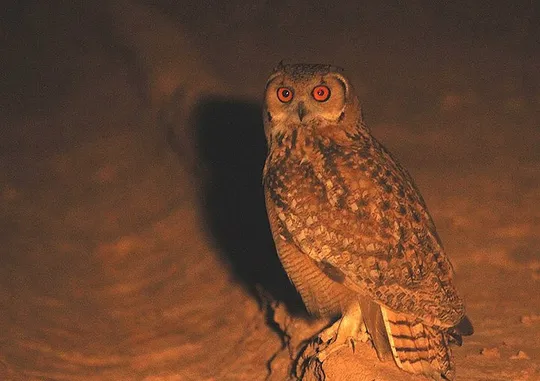Asio flammeus
 Critically Endangered
Critically Endangered

| Habitats | Wetland Thickets, Cropland, Humid Lowlands |
|---|---|
| Presence In Israel | Summer |
| Breeding In Israel | Breeder |
| Migration Types | Nomad |
| Zoographical Zones | Mediterranean |
| Landscape Types | Plains & Valleys, Wetlands, Marsh, Wetland Thickets |
| Vegetation Types | Cropland, Herbaceous, Marsh and Riparian |
| Vegetation Densities | Medium, Low |
| Nest Locations | Ground |
| Diet Types | Terrestrial Vertebrates |
| Foraging Grounds | Ground |
| Body Sizes | Small (up to 500g) |
| Threat Factors | Pesticide Poisoning, Habitat loss and fragmentation, Nest destruction by agricultural activity, Wetland Drainage & Pollution |
The Short-eared Owl is a medium-sized owl, with a dark brown striped plumage on its upper parts and breast, and pale cream on its lower parts. Eyes are yellow and “ear” tufts are short. It is a nocturnal species that also hunts in daylight, often in full light, in the morning and afternoon. Hunting method resembles harriers, as it flies low with raised wings surveying the open fields below. Usually flies against the wind using hearing as the main sense in locating prey.
The Short-eared Owl was apparently a rather rare breeder in northern and central Israel until the 1970s, particularly in “vole years” (Sela 1975, Paz 1986, Shirihai 1996). Since then the number of nesting observations has decreased considerably. In spring 1998, a farmer collected a nest with nestlings in the Hamadia area (Bet She’an Valley) (Kobi Merom, pers. comm.). In 2005, a fledgling was hit by a vehicle near Gedera, and three family groups were seen in the Judean Lowlands in spring 2016, which was a “vole year” in that area (Ezra Hadad, pers. comm.).
Nests on the ground, usually in marshes, wetlands and meadows. It also overwinters in arid areas in the desert transition area and in coastal sand dunes.
The Short-eared Owl nests on the ground, usually in marshes, wetlands, meadows and agricultural fields. It was impacted by marsh drainage, changes and destruction of fallow areas, as well as by secondary poisoning by agricultural pesticides. Individuals nesting in cultivated fields are vulnerable to injury by farming equipment or by eruptive species such as jackals, mongooses and crows. There is no data regarding how the species is affected by the increase in barn owls used for pest control in agricultural areas (over 2,000 nesting boxes have been erected; Yossi Leshem pers. Comm.).
No specific conservation measures have been taken for this species to date.
The Short-eared Owl is classified as Critically Endangered (CR) because of the extremely small number of breeding pairs in Israel. It is possible that the species breeds in Israel only in years with vole eruptions. There is a lack of comprehensive surveys in potential nesting areas such as the Golan Heights, the Northern Valleys and the Judean Lowlands.
The quality habitats, in which nesting Short-eared Owls were found in recent years (mostly in the Judean Lowlands) should be preserved. There is need of comprehensive surveys to determine the possibility of its presence in areas where it once nested, such as the Golan Heights, the Jordan Valley and the Judean Lowlands. Also, data regarding interactions between Short-eared Owls and other raptor species should be researched. Nest boxes for Barn Owls and Common Kestrels should not be put in Short-eared Owl nesting areas.
- פז, ע. 1986. עופות. מתוך אלון, ע. (עורך), החי והצומח של ארץ ישראל. כרך 6. הוצאת משרד הביטחון, ישראל.
- Mendelssohn, H. 1975. Report on the Status of Some Bird Species in Israel in 1974. I.C.B.P. 12:265-270.
- Shirihai, H., 1996. The Birds of Israel. Academic Press, London.
- Symes, A. 2013. Species generation lengths. Unpublished, BirdLife International.
- Species page at Birdlife International
Current Occupancy Map
| Data Missing | Sporadic | Limited Sites | Low Density | High Density |
|---|---|---|---|---|
| 0 | 0 | 0 | 0 | 0 |
Distribution maps
The maps presented here provide visual information on the distribution of species in Israel from the past and present, and the changes in occupancy and breeding density during the comparison period. For further reading
Relative Abundance 2010-2020
Breeding density values in the current decade as determined from experts' opinion and observations from databases.
| Data Missing | Sporadic | Limited Sites | Low Density | High Density |
|---|---|---|---|---|
| 8 | 12 | 12 | 21 | 19 |
Relative Abundance 1980-1990
Density values based primarily on the book The Birds of Israel (Shirihai 1996).
| Data Missing | Sporadic | Limited Sites | Low Density | High Density |
|---|---|---|---|---|
| 5 | 14 | 14 | 17 | 22 |
Occupancy 1990-2020
The map shows differences in the species breeding distribution between the 1980's breeding map and the current weighted breeding evaluation. Negative value - species previously bred in the grid and is not presently breeding; positive value - species has not previously bred in the grid and is currently breeding.
| Data Missing | No Change | Occupancy Increase | Occupancy Decrease |
|---|---|---|---|
| 6 | 35 | 1 | 9 |
Change in Relative Abundance 1990-2020
The map shows the changes in the relative abundance of a species in each of the distribution grids between the breeding map of the 1980s and the weighted current breeding evaluation. Negative values - decline in abundance; positive values - increase in abundance; zero - no change in abundance.
| 80 to 100 | 50 | 20 to 30 | No Change | 30- to 20- | 50- | 100- to 80- | Data Missing |
|---|---|---|---|---|---|---|---|
| 0 | 4 | 2 | 22 | 12 | 14 | 11 | 16 |
| Rarity | |
|---|---|
| Vulnerability | |
| Attractiveness | |
| Endemism | |
| Red number | |
| Peripherality | |
| IUCN category | |
| Threat Definition according to the red book |
 Contributed:
Contributed: 




